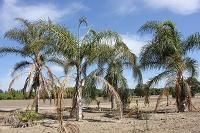Nursery & Landscape
187 - Biology and Management of Plant Parasitic Nematodes on Turfgrass
Principal Investigator: Dr. Becky Westerdahl, Department of Nematology, University of California – Davis. For more project information, click here.
Plant parasitic nematodes are microscopic roundworms that can be a major problem in turfgrass maintenance. The organophosphate nematicide Nemacur (fenamiphos) has been used in the management of nematodes on commercial turfgrass in California. Nemacur has been withdrawn from the market, and replacement management techniques are needed. There are currently no control measures available to California homeowners. A number of organic soil amendments and more conventional nematicides have been developed that have potential to reduce nematode damage to established turf. In addition, information on the biology and pathogenicity of nematodes on turfgrass is needed to develop environmentally sensitive programs for nematode management. Trials on the biology and management of plant parasitic nematodes on turf will be conducted on turfgrass plots that are currently available at SCREC.
154 – Selection of Lilacs with Low Winter Chill Requirements
Principal Investigator: Dr. Giles Waines, Department of Botany & Plant Sciences, University of California – Riverside. For more project information, click here.
The adaptation of 29 cultivars of lilac (Syringa) will be observed in a four-replicated field trial over three years to see if other cultivars than the three identified will prove adapted to coastal Orange County conditions. Of especial interest if whether Russian and Canadian germplasm will prove adapted, possibly on alternate years. A second objective is to observe whether death of old branches in summer is due to natural dieback, or due to possible susceptibility to Pierce's disease, which is a problem among lilac plantings at Riverside. Other pests and diseases will be monitored.
193 – Mineral Nutrition and Fertilizer Management for Landscape Palms
Principal Investigator: Dennis Pittenger, Department of Botany & Plant Sciences, University of California – Riverside. For more project information, click here.
Palms are commonly used in California’s urban and suburban landscapes and mature specimens are the emblematic signature landscape plant in coastal and Southern California. Several palm species commonly exhibit severe chlorosis and flecking on their leaves that greatly reduces their aesthetic value and appears to reduce their growth. It is likely that the responses are symptoms of nitrogen, magnesium, and/or potassium deficiency, but there is very limited reliable information on adequate tissue nutrient content or fertility management of palms grown in landscapes with a Mediterranean climate. This project will determine the Mg, K, and N requirement of landscape palms under California environmental conditions.
196 – Effect of Sand Backfill on Palms
Principal Investigator: Donald R. Hodel, Environmental Horticulture Advisor, UC Cooperative Extension. For more project information, click here.

The project will develop research-based recommendations regarding the use of builder's sand or native site soil as the back fill medium.
Ten specimens of queen palms will be dug and then replanted, using either builder's sand or native site soil as the back fill medium. The experimental design is a randomized complete block with two treatments (builder's sand and native site soil) and five, single-tree replications of each treatment. Palms will be rated for survival and leaf growth quarterly. Data will be subjected to ANOVA and other statistical tests as required.
207 – Autumn Sage Cultivars and New Selections
Principal Investigator: Dr. Giles Waines, Department of Botany & Plant Sciences, University of California – Riverside. For more project information, click here.
Autumn sages, Salvia greggii, S. microphylla, related species, hybrids (S. x jamensis), commercial cultivars, and new selections are valuable ornamental plants suited to water-wise gardening in Southern California. They bloom usually from spring into the fall, but mostly have a bloomless period in winter. This project will determine the start of flowering in spring and its cessation in fall at Riverside ARS and SCREC (Orange County) which have different temperature regimes typical of Southern California home gardens. With this knowledge it may be possible to breed and select cultivars that bloom year round. We will also determine the horticultural and ornamental performance of seed-grown plants with a tap root and laterals versus cutting produced plants with only adventitious roots. Entries will be ranked for bloom time, flower number, disease and pest resistance, and ornamental performance for home gardens and the nursery trade.
209 – UC Verde Foundation Block
Principal Investigator: Dr. Victor Gibeault, Emeritus Cooperative Extension Environmental Horticulturist, University of California – Riverside. For more project information, click here.
This project is for the maintenance of the mother block of ‘UC Verde’, a UC patented buffalograss. The site is available to the public to demonstrate low-water requiring landscape plant material in a block of sufficient size to clearly show the plant characteristics. At the same time, it is important to retain a secure and protected mother block of the grass to minimize the chance of any contamination. Interest in this warm season grass stems from the low-water use characteristics; the unique dormancy / drought avoidance ability of turfgrass to survive summers with no supplemental water, if needed, when irrigated again in late summer; and the pleasing aesthetic appearance of the turfgrass under varying mowing heights and when used as a “no-mow” ornamental ground cover. The recent drought years in California, and the Southwest, and a future of more expensive water and / or possible water restrictions for urban and suburban landscapes have highlighted the need for a resource efficient turfgrass, such as ‘UC Verde’.

